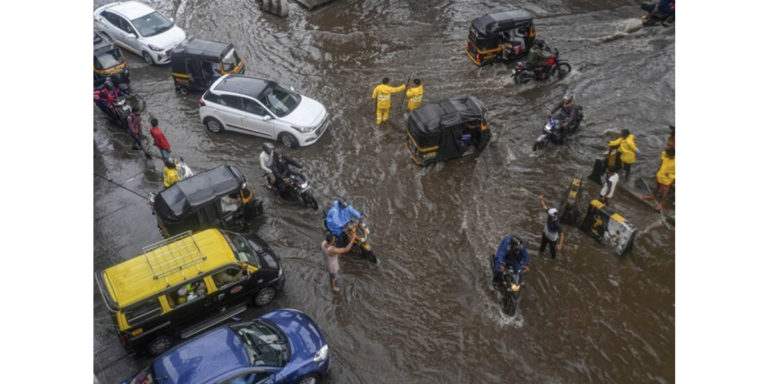Decoding weather forecasting is not as easy as reading the daily prediction. The meteorologist is forever faced with the dilemma of balancing precision and probability in predictions. Raju Korti lists the challenges of accurate weather forecasting and says in India, these present a complex algorithm of many parameters.
Mark Twain is reputed to have said that climate is what we expect and weather is what we get. How many times has it happened that heavy rains were predicted and not even a drop fell? Or for that matter, a dry day was predicted but it poured cats and dogs enough to bring life to a standstill? While this happens almost every year, the weatherman always corners attention in terms of public ridicule and yet, is always taken in all earnestness.
What is rarely understood is weatherman has a tricky job to do. After all, it is only a “reasonable prediction” that is sometimes billed as “imperfect science.” Weather prediction in India presents a unique set of challenges due to its geographical diversity, climatic variability, and the influence of multiple weather systems. Predicting weather accurately in such a context requires sophisticated technology, continuous monitoring, and skilled interpretation of data. To arrive at an exact inference based on so many parameters is anything but easy. More so given the fact that these parameters can vary locally. So, let’s give the weatherman the benefit of doubt and know what makes it tricky for him.
India’s vast geographical expanse encompasses a wide range of topographies, including mountains, plains, plateaus, and coastal regions. Each of these areas interacts differently with weather systems, leading to varied micro-climates and localized weather patterns. For instance, the Western Ghats influence the southwest monsoon, leading to heavy rainfall on the windward side and rain shadow regions on the leeward side.
The Indian monsoon, a lifeline for agriculture and water resources, is notoriously difficult to predict accurately. Factors such as El Niño and La Niña oscillations, the Indian Ocean Dipole, and other global climate patterns influence its strength and distribution. A slight deviation in any of these factors can lead to significant changes in rainfall patterns across the country.
Extreme Weather Events
India experiences a wide range of extreme weather events, from cyclones in the Bay of Bengal and Arabian Sea to heatwaves, cold waves, and intense rainfall events. Predicting the intensity, track, and timing of these events is crucial for disaster preparedness and mitigation efforts.
While India has made significant strides in meteorological technology, including Doppler radars, satellite imaging, and supercomputing facilities, gaps in infrastructure and data collection still exist, particularly in remote and rural areas. This can affect the accuracy of weather forecasts, especially for localised events.
Accurate weather forecasting relies heavily on real-time data collection and analysis. Issues such as gaps in data coverage, inconsistent data quality, and delays in data transmission can hinder the forecasting process. Improving data infrastructure and quality assurance measures is crucial for enhancing prediction accuracy.
India experiences rapid transitions between seasons, such as the onset and withdrawal of monsoons, which can be challenging to predict accurately. These transitions are influenced by complex interactions between oceanic and atmospheric factors, making precise forecasting a daunting task. Weather variability directly impacts India’s agricultural sector, which employs a significant portion of the population. Unpredictable weather patterns can lead to crop failures, affecting food security and the national economy. Accurate weather forecasts are essential for farmers to make informed decisions regarding planting, irrigation, and harvesting.
Need for Accuracy
Timely and accurate weather forecasts are critical for public safety, particularly in densely populated urban areas prone to flooding, landslides, and other weather-related hazards. Effective communication of weather risks and early warning systems can mitigate the impact of these events.
Weather prediction in India is a complex and challenging task due to its diverse geography, monsoonal variability, extreme weather events, technological constraints, and the critical socio-economic implications of accurate forecasting. Continued advancements in meteorological science, coupled with improvements in data collection and infrastructure, are essential to enhance the reliability and timeliness of weather forecasts, thereby mitigating risks and supporting sustainable development efforts across the country. While perfect accuracy is challenging due to the complexity of the atmosphere, meteorologists employ several key approaches to make predictions as reliable as possible:
Observations: Weather predictions start with gathering current data from various sources such as satellites, radar, weather stations, and weather balloons. These observations provide information on temperature, humidity, wind speed and direction, air pressure, and more.
Computer Models: Meteorologists use numerical weather prediction models, which are complex computer simulations of the atmosphere.
Data Assimilation: This process involves integrating real-time observational data into the numerical models to create the initial conditions for the forecasts. Data assimilation helps improve the accuracy of predictions by reducing errors in the starting state of the atmosphere.
Ensemble Forecasting: Instead of relying on a single model run, meteorologists often use ensemble forecasting, which involves running the same model with slightly different initial conditions or model configurations. This approach helps to account for uncertainties in the initial data and model physics, providing a range of possible outcomes (probability forecasts).
Satellite Imagery: Satellites provide continuous images of clouds, storms, and other weather patterns from space. This data is crucial for tracking weather systems, especially over oceans and remote regions.
Climate Trends and Patterns: Understanding long-term climate trends and recurring weather patterns (such as El Niño/La Niña) can also inform short-term weather predictions. These patterns influence the likelihood of certain weather events occurring.
Expertise and Experience: Meteorologists combine their scientific knowledge with experience and intuition to interpret model outputs and make informed judgments about the weather. This human input is crucial for refining forecasts, especially in complex or rapidly changing weather situations.
Verification and Improvement: Forecast accuracy is continually evaluated against actual weather conditions to identify areas for improvement. Advances in technology, better understanding of atmospheric processes, and feedback from forecast performance contribute to ongoing improvements in prediction accuracy.
Ocean Buoys: Floating devices anchored in oceans and lakes equipped with sensors to measure water temperature, wave height, and currents. Oceanic conditions influence weather patterns, and buoys provide valuable data for forecasting marine weather.
Aircraft-based Instruments: Commercial and research aircraft equipped with instruments that measure atmospheric conditions during flights. This data supplements ground-based and satellite observations, particularly in remote or inaccessible regions.
Ground-based Sensors: Various specialised sensors and instruments deployed on the ground or on structures like bridges or towers to monitor micro-climates, urban heat islands, and other localised weather phenomena.
These devices and technologies work together to provide meteorologists with a comprehensive understanding of current weather conditions and enable more accurate predictions of future weather patterns and events. While no forecast can perfectly predict the weather days or weeks in advance due to the chaotic nature of the atmosphere, modern weather forecasting techniques have significantly improved our ability to anticipate and prepare for weather events, thereby saving lives and minimizing economic impacts.
It is worth mentioning here that a team from IIT Bombay has developed a hyperlocal weather forecasting system for Mumbai, offering precise predictions for specific neighbourhoods, streets, and areas across the city. The project, a collaboration with the MCGM Centre for Municipal Capacity Building and Research (MCMCR), is now available to the public via the Mumbai Flood App on Android devices.
Comparisons are always made about the accuracy of prediction in India as against those elsewhere in the world. While specific comparisons between India and other countries would require detailed analysis and specific data, developed countries generally tend to have more accurate weather predictions due to their advanced technological infrastructure, extensive data availability, and sophisticated modeling capabilities. However, advancements in meteorology and improvements in forecasting accuracy are ongoing globally, benefiting countries at various stages of development.
Until then, let’s make peace with the fact that the weatherman is always right. It’s just the weather that’s wrong.


 Raju Korti is a senior journalist with over four-decade experience of working in media institutions.
Raju Korti is a senior journalist with over four-decade experience of working in media institutions.